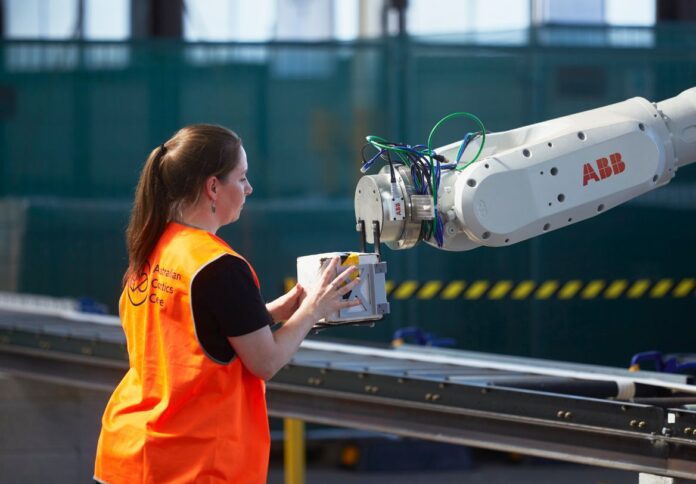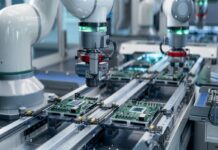
A large industrial robot and human dancer will perform an exclusive dance work before a crowd of 170 of Australia’s top roboticists and manufacturing industry leaders in Brisbane tonight.
The interactive ‘choreorobotic’ performance is a collaboration between QUT’s robotics Professor Jonathan Roberts and Dr Steph Hutchison, whose choreographic work has a focus on robotics, AI, motion capture and animation.
“I was fortunate to receive an Australian Network for Art and Technology (ANAT) Synapse residency and be supported by the Advanced Robotics for Manufacturing (ARM) Hub and QUT to co-create this performance,” Dr Hutchison said.
“Artists and scientists approach creativity, exploration, and research in different ways and from different perspectives – which we definitely need to explore in the digital age.”
Cobotic improvisation draws on dance improvisation and choreographic methodologies to research how humans might predict the movement of their robot collaborators.
“We’re not talking about a ‘Dancing with the Stars’ type of routine here,” said Professor Roberts.
“This is an interactive performance between robot and human in an industrial setting.”
“It’s about furthering our understanding of how people can predict robotic movements, which will help to better integrate people and robots in the workplace.”
QUT Senior Research Engineer Dr Dasun Gunasinghe and PhD candidate Marisa Bucolo are also involved in the performance.
Robots who work collaboratively alongside humans are known as cobots, and the exclusive performance will mark the highlight of the official launch of the Australian Cobotics Centre, an Australian Research Council-funded Industrial Transformation Training Centre based at QUT, the University of Technology Sydney and Swinburne University of Technology.
“Cobots can be used to do the parts of a job that are dangerous or require higher levels of physical strength, or that are highly repetitive, potentially reducing injury and incident rates,” said Professor Roberts, who heads up the new Centre.
“Collaborative robotics will benefit Australian companies, especially small businesses who will win on process innovation and lower costs, and manufacturing workers whose jobs will become safer and higher-skilled – and the economy benefits through the growth of jobs and exports.”
ARM Hub CEO Associate Professor Cori Stewart said she was delighted for ARM Hub to support cutting edge events that will further the use of robots in manufacturing.
“Queensland is recognised globally as a robotics powerhouse, with QUT the top robotics research and teaching university in Australia and CSIRO’s Robotics and Autonomous Systems Group based in Brisbane,” Dr Stewart said.
“Innovative collaborations such as this will only further our leadership and help us attract top robotics talent to Australia.”
The ANAT Synapse program involves Australian science organisations hosting artists in residence, leading to profound artistic and professional development for the participants, while also building a sustainable support base for interdisciplinary creative collaboration in Australia.
The ANAT Synapse program is supported by ANAT and ARM Hub, and is made possible through the generous support of the Copyright Agency’s Cultural Fund.


















